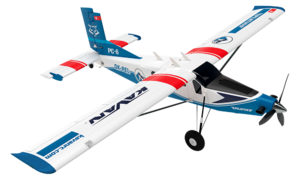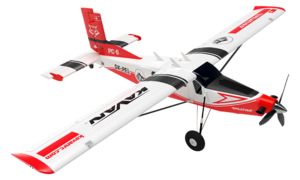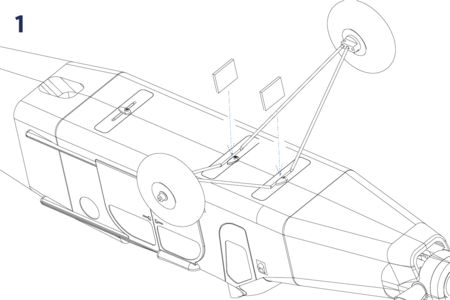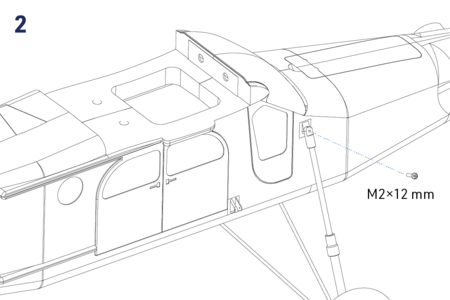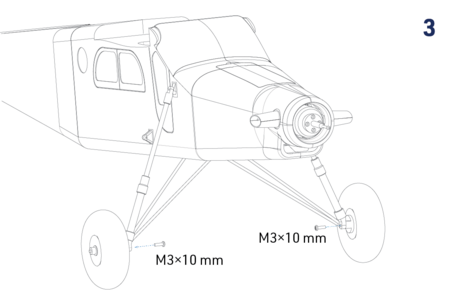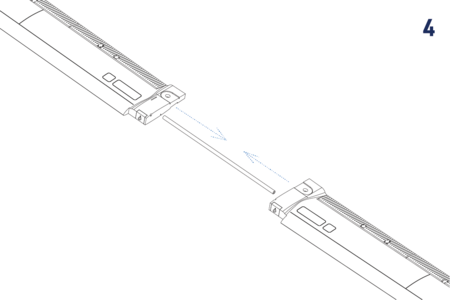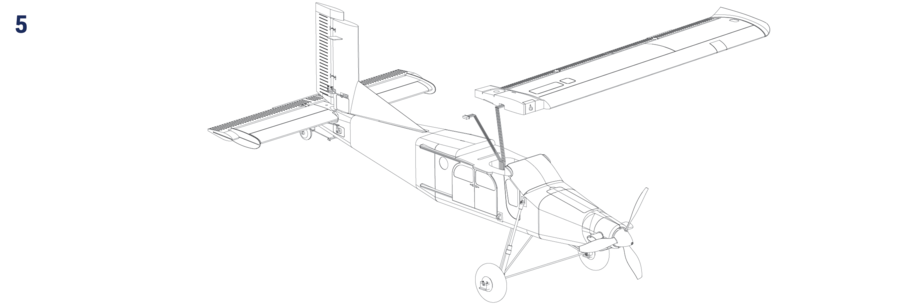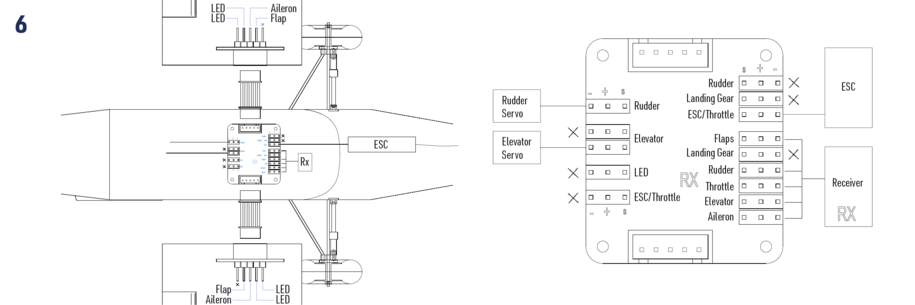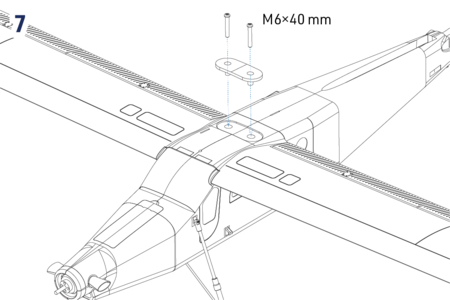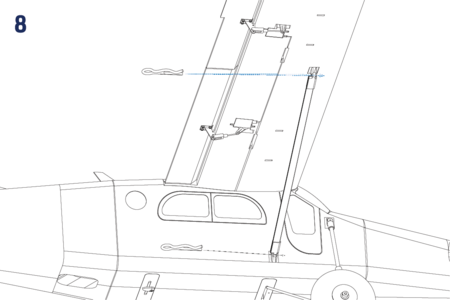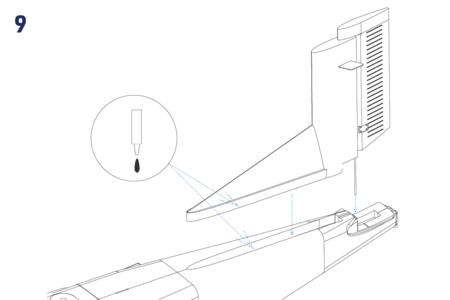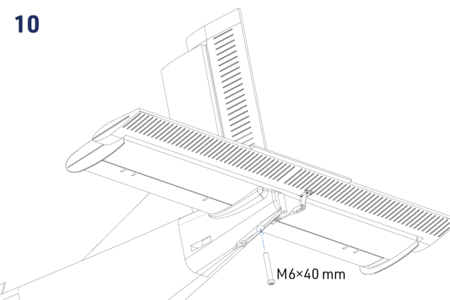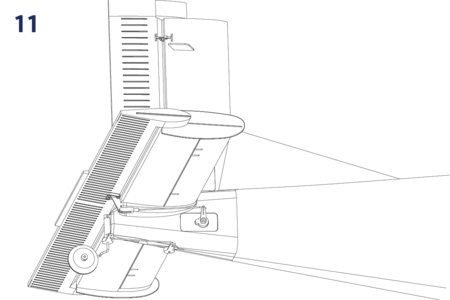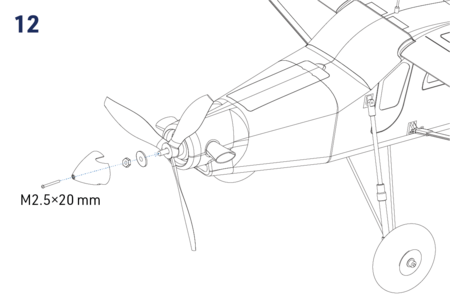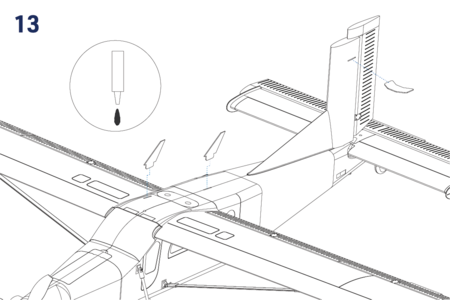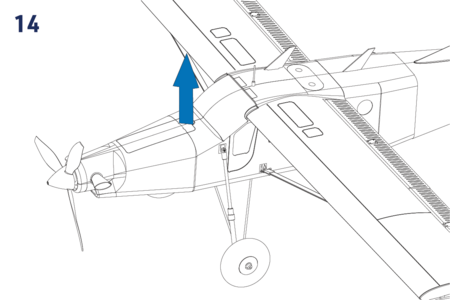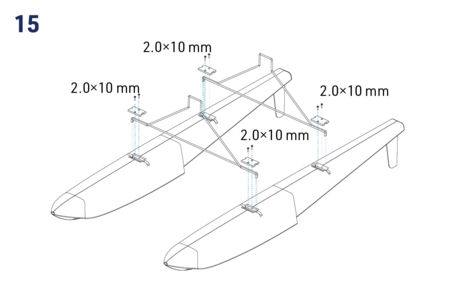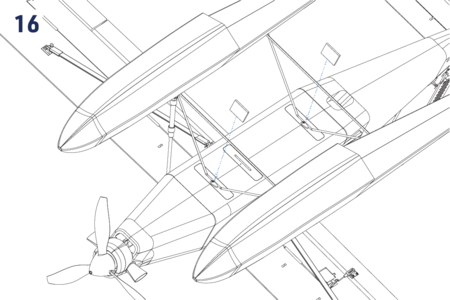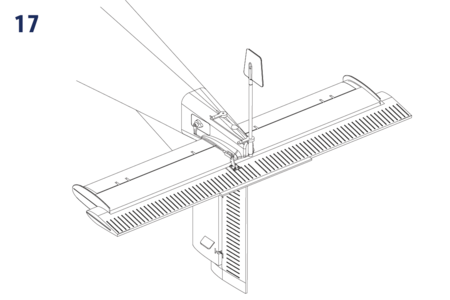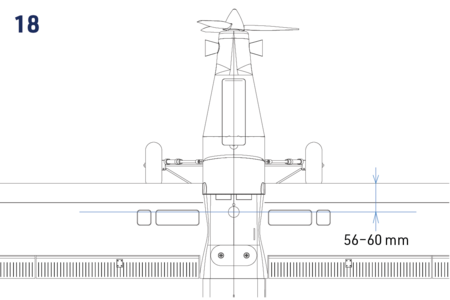KAVAN Pilatus PC-6 Porter - Instruction manual
Introduction
Congratulations on your purchase of the semi-scale model of the Pilatus PC-6 Porter STOL utility aircraft. You are about to start the assembly of a model manufactured from virtually unbreakable EPO (expanded polyolefin) foam, powered by a mighty brushless motor and lightweight LiPo battery. Everybody who has already mastered flying a "full-house" trainer - with aileron, elevator, rudder, and throttle control - will enjoy this beautiful semi-scale model.
Pilatus PC-6 Porter/Turbo-Porter
The single-engine Swiss STOL utility aircraft Pilatus PC-6 Porter, originally powered by the Lycoming flat six-cylinder engine, made its maiden flight in 1959. Soon an improved Turbo-Porter powered by a turboprop engine followed. Over the years Turbomeca Astazou II, Garret Air Research TPE 331 and ultimately Pratt & Whitney Canada PT6A (about 70 % of all PC-6 ever produced) turboprops have been taking this beautiful plane to the sky.
Incredible, almost helicopter-like short takeoff and landing capabilities have quickly gained the attention of military as well as commercial operators. Fitted with wheeled undercarriages, skis or floats, Porters have been serving reliably and relentlessly all over the world - flying over deserts, jungles, lakes, mountains, snow and ice - simply everywhere. No wonder the PC-6 holds the world record for the highest landing by a fixed-wing aircraft, at 18.865 feet (5.750 m), on the Dhaulagiri glacier in Nepal.
After 604 deliveries in 63 years, Pilatus ended production in 2022…
Specification (PC-6/B2-H4)
- Wingspan: 15.87 m
- Length: 10.90 m
- Basic operating weight: 1,250 kg
- Max. take-off weight: 2,800 kg
- Max. cruise speed: 232 km/h (125 KTAS)
- Take-off distance over 50 ft (15 m) obstacle (STOL): 440 m
- Landing distance over 50 ft (15 m) obstacle (STOL): 315 m
- Engine: Pratt & Whittney Canada PT6A-27
For more info about the aircraft visit: https://www.pilatus-aircraft.com
Before you start
- If you are not an experienced RC pilot, plan to have a fully competent pilot check your completed model and help you with your first flights. Even though we have tried to provide you with a thorough instruction manual, RC models are rather complicated and an experienced modeller can quickly check over your model to make sure your first flights are successful.
- Please assemble your model exactly according to these instructions. Do not attempt to modify or change your model in any way as doing so may adversely change its flying characteristics.
- Before you begin, please check the entire contents of this kit to make sure that no parts are missing or damaged. This will also help you to become familiar with each component of your plane. If you find that any of the parts are either missing or damaged, please contact your dealer immediately for replacement. Note: Your dealer cannot accept kits for return if construction has begun.
- Trial fit each part before glueing it in place. Make sure you are using the correct part and that it fits well before assembling. No amount of glue can make up for a poorly-fitting part.
- The manual contains a drawing showing the default position of the Centre of Gravity (CG) and recommended control surface throws. Please note it is essential to keep the recommended CG position for the first flight otherwise the model could be unstable, hard to control or even unable to fly at all! Later you can fine-tune the CG position to suit your flying style and skills.
Precautions
This RC model is not a toy. Use it with care and strictly follow the instructions in this manual.
Assemble this model following strictly these instructions. DO NOT modify or alter the model. Failure to do so, the warranty will lapse automatically. Follow the instructions to obtain a safe and solid model at the end of the assembly.
Children under the age of 14 must operate the model under the supervision of an adult.
Assure that the model is in perfect condition before every flight, taking care that all the equipment works correctly and that the model is undamaged in its structure.
Fly only on days with a light breeze and in a safe place away from any obstacles.
Safety precautions and warnings
- An RC aeroplane is not a toy! If misused, it can cause serious bodily harm and damage to property. Fly only in a safe place, following all instructions and recommendations in this manual. Beware of the propeller! Keep loose items that can get entangled in the propeller away from the spinning propeller, including loose clothing or other objects such as pencils and screwdrivers. Ensure that your and other people’s hands and faces are kept away from the rotating propeller.
- As the user of this product, you are solely responsible for operating it in a manner that does not endanger yourself and others or result in damage to the product or the property of others. This model is controlled by a radio signal that is subject to interference from many sources outside your control. This interference can cause momentary loss of control, so it is advisable to always keep a safe distance in all directions around your model, as this margin will help to avoid collisions or injury.
- Never operate your model with low transmitter batteries.
- Always operate your model in an open area away from power lines, cars, traffic, or people. Avoid operating your model in populated areas where injury or damage can occur.
- Carefully follow the directions and warnings for this and any optional support equipment (chargers, rechargeable batteries, etc.) which you use.
- Keep all chemicals, small parts and anything electrical out of the reach of children.
- Moisture causes damage to electronics. Avoid water exposure to all equipment not specifically designed and protected for this purpose.
- The model is made mostly of plastics - it is not fireproof. It may not be exposed to higher temperatures, otherwise severe distortion of the foam airframe or other damage may occur.
Technical specifications
| Wingspan | 1500 mm |
| Length | 1112 mm |
| All-up weight | 700–770 g |
| Wing area | 27.9 dm² |
| All-up weight | 1650–1700 g |
| Motor | C3548-750 |
| ESC | KAVAN R-40SB SBEC |
| Propeller | 10×6" 3-blade |
Set contents
Almost ready to fly model with the brushless motor, speed controller and servos installed, instruction manual.
You will also need
- At least 6-channel RC set, 14.8 V 2600–3300 mAh LiPo flight pack.
- Regular modeller’s tools: precision knife (KAV66.770), screwdrivers, pliers, No. 10 spanner, 1.5 mm and 2.5 mm Allen keys or screwdrivers, sandpaper etc.
- Glue: Medium or thick cyanoacrylate glue (e.g. KAV56.9952 or KAV56.9953), silicone or MS polymer glue.
Model assembly
- Push the undercarriage into slots in the bottom of the fuselage until you hear a "Click!", slide in the plastic inserts and secure by rotating the latches.
- Secure the upper undercarriage struts using M2×12 mm screws to the fuselage (do not tighten completely).
- Secure the struts to the undercarriage using M3×10 mm screws. Apply a drop of blue threadlocker to the screws but do not tighten completely.
- Slide the wing halves onto the wing tube joiner.
- Connect the wing multi connectors to the corresponding sockets in the wing halves.
- Hook up your receiver, servos and ESC following the wiring diagram (Fig. 6). The receiver is to be secured with a strip of double-sided foam tape or hook-and-loop tape to the rear part of the cockpit. Deploy the antennas so their active parts are square to each other (if you are using a receiver featuring diversity aerials).Note: The kit is supplied with the connection board for ailerons, flaps, rudder and LED lights so you can use even the most basic 6-channel radios to control your PC-6 Porter. If you intend to use independent control of aileron and flap servos and an advanced computer radio, you have to bypass the connection board accordingly with a pair of wing reduction cables (e.g. KAV02.8091.9).
The LED lights are only powered via the connection board; they are not remote-controlled in any way. - Attach the wing to the fuselage and secure by the wing joiner plate and two M6×40 mm plastic bolts.
- Attach the wing struts and secure them with two clips each.
- Trial the fit of the horizontal and vertical tailplane and the fuselage - no glue yet. Double check the parts fit tight and the fin is vertical to the horizontal stabilizer. If necessary sand the parts to fit. Once satisfied, apply medium or rather thick cyano (or clear silicone or MS polymer glue) to the contact area of the fin and attach the fin to the fuselage.
- Insert the horizontal tailplane in place and secure it with the M6×40 mm plastic bolt.
- Install the tail wheel and the rudder/tail wheel linkage. Do not forget to apply a drop of blue threadlocker to the setting screws.
- Attach the propeller to the prop driver and secure it with the propeller nut with a washer; tighten the nut using a No. 10 spanner. (For your safety, you should better leave the propeller installation after your radio is all connected and set and the correct direction of rotation of your motor has been tested.) Secure the spinner using an M2.5×20 mm bolt in place.
- Use medium cyano to glue the dummy antennas in place.
- Open the battery compartment hatch, and put your flight pack inside. With your radio on, set the servos to the neutral position (sticks and trims centred) and fasten the setting screws of the pushrod connectors on the elevator and rudder servo arms. Perform the throttle range calibration of the ESC as described in the attachment of this manual.
Float Set Installation (optional - sold separately) - Attach the struts to the floats and secure them with plastic braces and 2.0×10 mm self-tapping screws.
- Push the struts into slots in the bottom of the fuselage until you hear a "Click!", slide in the plastic inserts and secure by rotating the latches.
- Install the water rudder in place. Do not forget to apply a drop of blue threadlocker to the setting screw.
RC kit installation and pre-flight check
| Recommended throws | *Low Rate | High Rate | ||
|---|---|---|---|---|
| Rate | Expo | Rate | Expo | |
| Ailerons | ±11 mm | 30 % | ±15 mm | 30 % |
| Elevator | ±11 mm | 30 % | ±20 mm | 30 % |
| Rudder | ±16 mm | 20 % | ±25 mm | 20 % |
| Flaps | Take-off: -10 mm down / Landing: -22 mm down | |||
- Referring to the instruction manual of your radio, carefully hook up the on-board electronics.
- Once everything has been correctly connected, turn on your transmitter and plug in the flight pack. Check the neutral positions and throws of all control surfaces. If you need to make the control surface throws smaller, simply move the pushrod closer to the centre on the servo arm or move it far from the control surface on the control horn. And vice versa.
Especially less experienced pilots might find their Porter easier to fly with some extra mixes on (mix rates for the high rate throws):
- Aileron → Rudder: 12 mm left rudder at full left ailerons, 12 mm right rudder at full right ailerons
- Aileron differential: 15 mm up aileron/8 mm down aileron
- Flap → Elevator: 1 mm down elevator for take-off flaps, 2 mm down elevator for landing flaps setting.
- Check the direction of rotation of the propeller. If it is incorrect, simply swap two of the three wires between the ESC and motor or program the ESC (refer to the ESC manual).
- Check the correct position of the centre of gravity (CG): 56–60 mm behind the leading edge of the wing (Fig. 18). Adjust the CG position by moving the flight pack - if you cannot reach the recommended position, do not hesitate to add an appropriate amount of lead to the nose or tail. An extra couple of grams won’t spoil the flying characteristics - but the incorrect CG position is a killer.
- Fully charge your flight pack and transmitter batteries, check the proper function of your radio and perform the range check of your radio according to its instruction manual. The range has to be almost the same with the motor off and at full throttle (no more than a 10% decrease is acceptable). DO NOT try to fly unless the range check is 100% successful.
Flying
The test flying and fine-tuning is pretty much straightforward. There will be no surprise for a medium-advanced pilot who is supposed to fly this model.
"Sea" Porter
It is a good idea to test-fly your Porter with the wheels first just to make yourself familiar with your new model. Explore the safe take-off and landing approach speed, and learn to use the flaps. Once the floats are installed, check again the CG position; adjust the battery position and/or add ballast if necessary.
For the first test flights, seek an open area of calm water. Try to avoid lakes surrounded by tall trees causing turbulence above water. Tall trees would also force a dangerously steep climb right after your model gets into the air. Choose a fine day with a gentle breeze - the take-off is easier when there are small waves than from a glass-still lake.
Prepare the model as usual and check the RC set and power systems are working properly. Place your model in the water, pull the elevator up and gently open the throttle to taxi away from the bank. The model should be easy to control thanks to the efficient water rudder. Once away enough, switch the motor off, and the model will turn itself directly against the wind thanks to the "weathercock" effect of the fin.
Open the throttle and allow your model to gain speed until it rises onto the step of the floats. Leave the elevator at the neutral position; do not apply the up elevator until the model actually gains the take-off speed (a little bit bigger than with wheels). Gently apply the elevator. Do not force your model into a steep climb or sharp turn. The increased drag caused by the floats makes your Porter respond more slowly. The level flight also requires a higher throttle setting. Allow your model to climb to a safe height (50 m or so), and take your time to get the feel of your new floatplane. You should try a couple of landing approaches - at first at a safe height, and at a low level later.
However, do not get carried away by your beautiful seaplane. Remember you have to spare enough energy not only for a safe landing but also for taxiing back. Allow your model to descend steadily by keeping the throttle a little bit more open than with a land-based plane. Let your model touch down gently and smoothly on the water.
Once "docked", check if there is no water inside your model. Dry it thoroughly with a sponge if necessary. Check for any signs of damage by objects in the water and thoroughly check the water rudders.
At the end of your water flying session, carefully and thoroughly clean and dry your model from outside and inside. It is wise to carry a bottle of fresh water, a sponge and a piece of fine dry cloth with you to the lake. The exposed metal fittings might be happier if protected by a drop of WD-40 spray lube.
Appendix
KAVAN R-40SB instructions
Please refer to the KAVAN ESCs - Instruction manual.
Recycling and Waste Disposal Note (European Union)

Electrical equipment marked with the crossed-out waste bin symbol must not be discarded in the domestic waste; it should be disposed of via the appropriate specialised disposal system. In the countries of the EU (European Union) electrical devices must not be discarded via the normal domestic waste system (WEEE - Waste of Electrical and Electronic Equipment, Directive 2012/19/EU). You can take your unwanted equipment to your nearest public collection point or recycling centre, where it will be disposed of in the proper manner at no charge to you. By disposing of your old equipment in a responsible manner you make an important contribution to the safeguarding of the environment!
EU Declaration of Conformity (European Union)

Hereby, KAVAN Europe s.r.o. declares that this Pilatus PC-6 Porter model and the included electronic and electric devices are in compliance with the requirements of relevant European directives and harmonized norms. The full text of the Declaration of Conformity is available at www.kavanrc.com/doc/.
Guarantee
The KAVAN Europe s.r.o. products are covered by a guarantee that fulfils the currently valid legal requirements in your country. If you wish to make a claim under guarantee, please contact the retailer from whom you first purchased the equipment. The guarantee does not cover faults which were caused in the following ways: crashes, improper use, incorrect connection, reversed polarity, maintenance work carried out late, incorrectly or not at all, or by unauthorised personnel, use of other than genuine KAVAN Europe s.r.o. accessories, modifications or repairs which were not carried out by KAVAN Europe s.r.o. or an authorised KAVAN Europe s.r.o., accidental or deliberate damage, defects caused by normal wear and tear, operation outside the Specification, or in conjunction with equipment made by other manufacturers. Please be sure to read the appropriate information sheets in the product documentation.
